News
Ancient capital’s landmarks lie unprotected
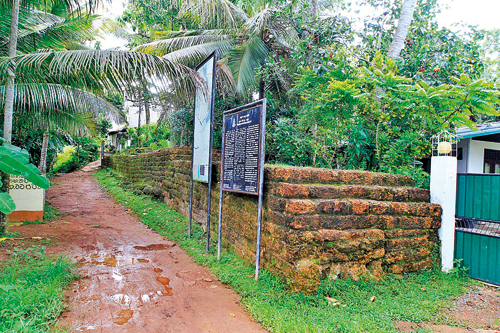
Part of the Kotte rampart that's left in Beddagana: Houses have been built on this and vehicles traverse regularly. Pix by Indika Handuwala
Archeological conservation has lately become a topic of controversy in light of the recent clashes between the Archeological Department and the people of the North and East of Sri Lanka. Despite the heated debates on heritage and culture, negligent urbanisation and severe budget cuts, that officials say are related to the coronavirus disease pandemic, are waging a war of their own on rich ancient history right here in Sri Lanka’s capital.
The Kotte Kingdom which lasted for almost two centuries was Sri Lanka’s first ancient kingdom to face Western colonisers.
According to resources from the E.W. Perera Museum in Kotte, out of 28 potential archeological sites that should exist, 8 have been discovered and conserved. Tthe more well-preserved ancient ruins of Anuradhapura and Polonnaruwa are 400 years and 200 years respectively older than the Kotte Kingdom.
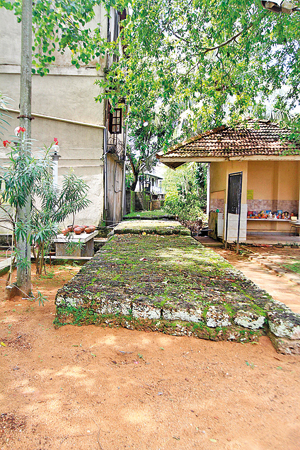
A section of rampart preserved within Perakumba Pirivena
Earlier this week, the Sunday Times visited the remnants of the Kotte Kingdom for this investigation. The Kotte Ambalama, a rest for weary travellers in the 15th century, now a refuge for commuters from the rain and sun, is relatively well maintained as it also doubles as a roof for people that are homeless who keep it clean.
“The road becomes more convenient and accessible without the structure, but we appealed for it to be left alone in the name of conservation,” noted Kotte Raja Maha Viharadipathi Anurudda Nayaka Thera, the chief prelate of another of Kotte’s archeological treasures whose historical integrity has been maintained, save for a few locations that require deeper archeological investigation, within the temple.
He said that conservation is more challenging because the Kotte Kingdom’s primary construction material was “caboc”, laterite, and not granite as in many other ancient kingdoms. Interestingly, during its investigation, the Sunday Times observed caboc blocks removed from ruins being used in modern home gardens for tree beds and as stepping stones.
“The damage done to the kingdom, especially by people in the areas, is quite bad,” the chief prelate said, adding that the most protected archeological sites of the Kotte Kingdom were found within the temples of the area.
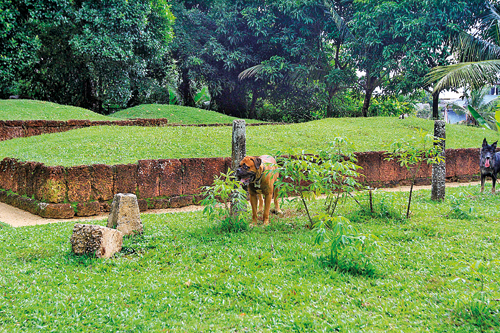
Alakeshwara tomb where neighbours dogs were drying off after a bath amidst the manioc plants planted by govt. officials
Institutionalised Buddhism was, as the thera accurately noted, the best defence Kotte Kingdom had seen against its dilapidation. Parts of ancient stone inscriptions in the Sunethra Devi Pirivena, Pepiliyana, while freely on display for the public, are one of the only artifacts that have been fenced off in the entirety of the archeological area.
The stretch of rampart within the Perakumba Pirivena along Parliament Road was another observation that the Sunday Times made during its investigation. The Kotte rampart, famous for fortifying the formidable kingdom that withstood multiple invasions, is estimated to have been built in the 14th century. At its prime, the city wall which was also the marching ground for elephants and performers of the Kotte Perahera covered the entirety of the ancient capital of Kotte — now only 1.5/2 km remain.
The remains found within the Perakumba Pirivena are about 5 feet wide but become narrower as one walks on it over to the private lands that it now stands on, and disappears altogether into private properties that have encroached and destroyed it.
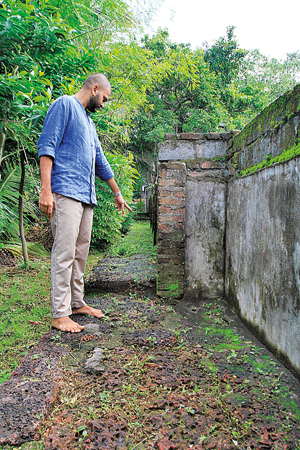
Part of the Kotte Rampart on Parliament Road that narrows and disappears once outside the territories of the Perakumba Pirivena
“The oversight that currently happens is mostly reactive, not proactive,” noted Ven. Mahiyanganaye Panyananda Thera of the Perakumba Pirivena. He said conservation would ideally happen before archeological sites are threatened by modern buildings being put up. As of now the Archeology Department’s protection of sites is primarily activated when someone tries to build in the vicinity.
Remnants of the rampart found in Beddagana are even more sparse as the area is congested with houses that have been built on it. Walls run through this bit of rampart and the moat attached to it and vehicles regularly move up and down it despite a Department of Archeology board that details its historic value recognised under the 1940s Act, which is the legal instrument outlining archeological recognition and conservation in Sri Lanka, displayed at the entrance.
“We have actually processed legal proceedings against 100 of these settlements that are encroaching the rampart,” said Sugath Atharasinghe Archeology Department zonal officer of Kotte.
The joint initiative by the department and the Kotte municipality began this year and preliminary operationalisation was finalized just this week following two months of surveying. Mr Atharasinghe said however that city planning which fails to value archeological heritage for decades was part of the problem.
“It’s better now, and there is more collaboration between the Municipal Council and Urban Development Authority. The biggest obstacle to protection and conservation is budgetary. We have about 8 permanent staff who have to cover about 10 acres of sites and maintenance is a huge challenge,” he said noting that the department finds it difficult to purchase petrol and lacks equipment like lawnmowers, especially in places like the inner moat and outer moat of the city.
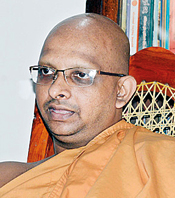
Ven. Mahiyanganaye Panyananda Thera
Before coronavirus disease-related budget cuts, the Kotte Department maintained 50-100 feet of the rampart most of which is now overgrown. Site protection is also severely lacking. The ruins of Vehera Kanda mausoleum which houses the remains of King Parakramabahu VI and his wife, is pervaded by a ‘pin haraka’ that sometimes attacks visitors.
The Sunday Times also visited Alakeshwara tomb and discovered manioc plantations and pet dogs of neighbours drying off after their baths tied to the pillars.
“We try to maintain good relationships with the neighbours because they help us with its protection,” Mr Atharasinghe said noting the intruders.
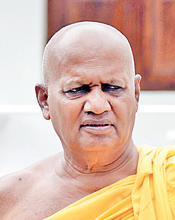
Ven. Kotte Raja Maha Viharadipathi Anurudda Nayaka, Chief Prelate of the Kotte Raja Maha Viharaya
The one consistent protection the site has is the neighbour in question’s CCTV cameras that also cover the site. The manioc plantation, unsuccessful due to the infertile soil, is a result of a Government initiative to deal with the country’s food insecurity. “The funds needed to fence these areas off have not come through yet so we are struggling with that especially since finances have got tougher for the Government with the crisis,” he said.
However, experts noted this was unacceptable where conservation efforts were concerned.
Founder of the Kotte Heritage Foundation Prasad Fonseka rooted this issue back to the education system, which, he claims fails to appreciate Sri Lanka’s history.
The independent researcher who has authored one of Kotte Kingdom’s most popular books “Kotte: the fortress” says the systemic destruction has been perpetuated by the country’s leaders for decades now .
Shortfalls that go beyond budget constraints, which include loopholes in the Archeology Act and its amendments and the lack of substantial research resources have resulted in the steady disappearance of one of Sri Lanka’s most important portions of history in the very capital of Sri Lanka.
The best way to say that you found the home of your dreams is by finding it on Hitad.lk. We have listings for apartments for sale or rent in Sri Lanka, no matter what locale you're looking for! Whether you live in Colombo, Galle, Kandy, Matara, Jaffna and more - we've got them all!

